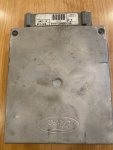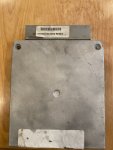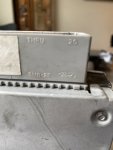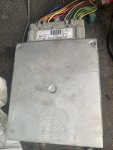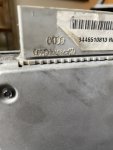I ran a KOEO scan on my Ranger and got a 11 (OBD 1) pass code on the EEC but after setting the base timing and trying a KOER running scan I got a message saying that DTCs could not be retrieved and no CYL ID found. Does anyone know where the CYL ID comes from? Is it read off the EEC or from the ignition PIP? This engine runs extremely rich and I’m trying to figure out why. Thanks for any info.
-
 Welcome Visitor! Please take a few seconds and Register
for our forum. Even if you don't want to post, you can still 'Like' and react to posts.
Welcome Visitor! Please take a few seconds and Register
for our forum. Even if you don't want to post, you can still 'Like' and react to posts. 
You are using an out of date browser. It may not display this or other websites correctly.
You should upgrade or use an alternative browser.
You should upgrade or use an alternative browser.
1988 Ranger 2.3 A4LD 2WD no CYL ID on scan
- Thread starter Sellis737
- Start date
franklin2
Well-Known Member
It comes from the computer itself and is one of the first set of data to come through. It verifies you have a 4 cyl computer on a 4 cyl engine, a 6 cyl computer on a 6 cyl, or a 8 cyl computer on a 8 cyl engine. Apparently they will all plug in and can get mixed up.
Thanks for the reply and your information may be a key piece of information to the puzzle I’m trying to solve. This engine runs super rich and is getting much more fuel than it should. The EEC is not the original unit. I can tell because of an earlier date code (E7TF) and a remanufactured label attached. I don’t know if it ever ran well with this EEC since I salvaged the truck from the crusher initially as a parts truck for my 83 Ranger. I suspect this unit is for a 2.9 V6 but just a guess because I don’t know where to find the suffix information from the EEC part number. I’m trying to locate a VIN correct replacement EEC but still searching. Your expertise is greatly appreciated.It comes from the computer itself and is one of the first set of data to come through. It verifies you have a 4 cyl computer on a 4 cyl engine, a 6 cyl computer on a 6 cyl, or a 8 cyl computer on a 8 cyl engine. Apparently they will all plug in and can get mixed up.
Sean
- Joined
- Oct 31, 2018
- Messages
- 7,825
- City
- Dirtman's Basement
- Vehicle Year
- 1988
- Transmission
- Manual
- My credo
- Give 'yer balls a tug. Fight me.
Post photo of all labels/stamps on EEC.Thanks for the reply and your information may be a key piece of information to the puzzle I’m trying to solve. This engine runs super rich and is getting much more fuel than it should. The EEC is not the original unit. I can tell because of an earlier date code (E7TF) and a remanufactured label attached. I don’t know if it ever ran well with this EEC since I salvaged the truck from the crusher initially as a parts truck for my 83 Ranger. I suspect this unit is for a 2.9 V6 but just a guess because I don’t know where to find the suffix information from the EEC part number. I’m trying to locate a VIN correct replacement EEC but still searching. Your expertise is greatly appreciated.
Sean
I have a few spreadsheets of what's what
Check the Fuel Pressure Regulator(FPR) vacuum hose
There are two fuel lines coming into the engine bay
IN from pump/filter goes directly to fuel rail
RETURN to tank goes to FPR, small cylinder device, and it has a Vacuum hose attached
If FPR should leak, then raw fuel will be sucked into the engine in the vacuum hose
Check the hose for gasoline, replace FPR if found
All fuel injection computers have a "Clear Flooded Engine" routine, this routine shuts off injectors while you crank the engine over to DRY IT OUT
Turn on key
Press gas pedal down to the floor and hold it down all the way
Throttle sensor at WOT(wide open) and RPMs at 0 = turn off injectors to Clear Flooded Engine
Crank engine
It should not start or even fire, there is spark but no fuel
If you release gas pedal even while still cranking injectors will start
Point of test is to see if you have a leaking injector, engine would start because fuel is leaking in
Obviously check the FPR first
Then do the Clear Flooded Engine test
If the engine starts then do this
Unplug BOTH coil packs 3 wire connectors so no spark
Do Clear Flooded Engine test again but crank it a few times
Now pull 1 spark plug from each cylinder
The one with the WET tip has the leaking injector
There are two fuel lines coming into the engine bay
IN from pump/filter goes directly to fuel rail
RETURN to tank goes to FPR, small cylinder device, and it has a Vacuum hose attached
If FPR should leak, then raw fuel will be sucked into the engine in the vacuum hose
Check the hose for gasoline, replace FPR if found
All fuel injection computers have a "Clear Flooded Engine" routine, this routine shuts off injectors while you crank the engine over to DRY IT OUT
Turn on key
Press gas pedal down to the floor and hold it down all the way
Throttle sensor at WOT(wide open) and RPMs at 0 = turn off injectors to Clear Flooded Engine
Crank engine
It should not start or even fire, there is spark but no fuel
If you release gas pedal even while still cranking injectors will start
Point of test is to see if you have a leaking injector, engine would start because fuel is leaking in
Obviously check the FPR first
Then do the Clear Flooded Engine test
If the engine starts then do this
Unplug BOTH coil packs 3 wire connectors so no spark
Do Clear Flooded Engine test again but crank it a few times
Now pull 1 spark plug from each cylinder
The one with the WET tip has the leaking injector
Thank you! I did check the FPR for a leaking diaphragm and removed the fuel rail and checked the return line for blockage. I put a pressure gauge on the fuel rail also and pressurized the line by turning on the ignition a few times. The pressure goes right to 39 psi and stays there for at least 5 min with no pressure drop so I was thinking the injectors were not bleeding off pressure but I guess it could be different under cranking conditions. This is a distributor system with the Hall Effect sensor and single plug per cylinder but I will perform the WOT test and check for a wet plug as you described.Check the Fuel Pressure Regulator(FPR) vacuum hose
There are two fuel lines coming into the engine bay
IN from pump/filter goes directly to fuel rail
RETURN to tank goes to FPR, small cylinder device, and it has a Vacuum hose attached
If FPR should leak, then raw fuel will be sucked into the engine in the vacuum hose
Check the hose for gasoline, replace FPR if found
All fuel injection computers have a "Clear Flooded Engine" routine, this routine shuts off injectors while you crank the engine over to DRY IT OUT
Turn on key
Press gas pedal down to the floor and hold it down all the way
Throttle sensor at WOT(wide open) and RPMs at 0 = turn off injectors to Clear Flooded Engine
Crank engine
It should not start or even fire, there is spark but no fuel
If you release gas pedal even while still cranking injectors will start
Point of test is to see if you have a leaking injector, engine would start because fuel is leaking in
Obviously check the FPR first
Then do the Clear Flooded Engine test
If the engine starts then do this
Unplug BOTH coil packs 3 wire connectors so no spark
Do Clear Flooded Engine test again but crank it a few times
Now pull 1 spark plug from each cylinder
The one with the WET tip has the leaking injector
I also set the base timing to 10 degrees and tried the timing test to check for advance at 20 plus the base of 10 for 27-33 degrees and it was off and actually retards the timing with rpm? Strange. Truck was a salvage with no history just a very fascinating puzzle lol!
- Joined
- Oct 31, 2018
- Messages
- 7,825
- City
- Dirtman's Basement
- Vehicle Year
- 1988
- Transmission
- Manual
- My credo
- Give 'yer balls a tug. Fight me.
Weird. I'm not seeing FJ in the references I have.So this is the information that’s on the currently installed (uninstalled) EEC It’s hard to read the thermostamped code under the remanufactured label but it’s probably something put on by whoever rebuilt the EEC. Looks like EGDB-1A 4624-MA? View attachment 95325View attachment 95325View attachment 95326View attachment 95327View attachment 95328
Doesn't mean anything, tho.
Also doesn't mean that FJ is your catch code... reman boxes are.... weird.
The TwEECer -- Ford EEC user programmable module
The TwEECer is an adapter which connects to the J3 service port of 1984-2004 Ford EEC PCM, giving you the ability to substitute parameters in the calibration data with parameters that match the modifications which you have made to your engine combo. So as you add performance to your car, you...
www.tweecer.com
Good place to start. I'm not sure which strategy that box is.
I went through this with my 2.9 - trying to get a computer with the right strategy programmed. Some jackass on eBay kept sending me ones for 4.9/300.
B229218
New Member
What adaptor did u use to connect to fuel rail schrader valve?Thank you! I did check the FPR for a leaking diaphragm and removed the fuel rail and checked the return line for blockage. I put a pressure gauge on the fuel rail also and pressurized the line by turning on the ignition a few times. The pressure goes right to 39 psi and stays there for at least 5 min with no pressure drop so I was thinking the injectors were not bleeding off pressure but I guess it could be different under cranking conditions. This is a distributor system with the Hall Effect sensor and single plug per cylinder but I will perform the WOT test and check for a wet plug as you described.
I also set the base timing to 10 degrees and tried the timing test to check for advance at 20 plus the base of 10 for 27-33 degrees and it was off and actually retards the timing with rpm? Strange. Truck was a salvage with no history just a very fascinating puzzle lol!
The fuel pressure gauge came with several adapters but I believe the gauge hose threaded right on to the schrader valve on the fuel rail. I got the guage at Oriellys nothing fancy but it seems to work fine. I never did get the truck to run right. I’m letting it rest for a while
franklin2
Well-Known Member
I use the backyard fuel port adapter. I take the guts out of the test port schrader valve, slip a hose over it with a hose clamp, and have a pressure gauge on the other end of the hose. I can use a long hose and tape it to the windshield for testing on the road. No disasters yet doing it.
Similar threads
- Replies
- 5
- Views
- 6K
- Replies
- 2
- Views
- 1K
- Replies
- 5
- Views
- 4K
Sponsored Ad
Sponsored Ad
TRS Events
Latest posts
-
-
-
-
-
2011 Ford Ranger aftermarket headlight assemblies
- Latest: lil_Blue_Ford
-
-
-

